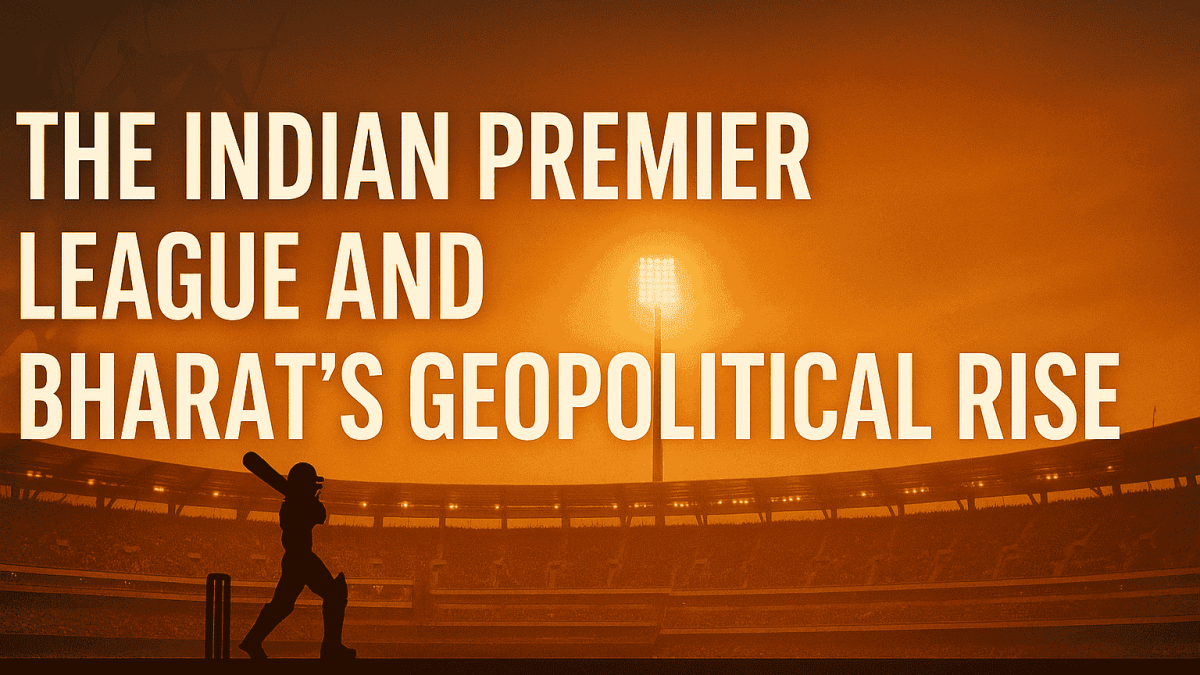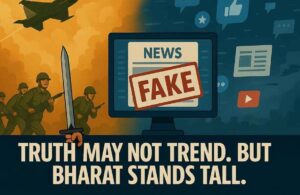AI-generated image
“I’ve watched kingdoms rise and empires crumble. I’ve seen friendships sealed with blood and rivalries simmer over centuries. But never—never—did I think that one day, a cricket league… yes, a league! The Indian Premier League… would become one of my strongest tools of influence in the world.”
I’ve worn many faces through time—Ashoka’s quiet resolve, Akbar’s searching wisdom, Gandhi’s gentle silence. And today, I live on—in the pulse of a billion hearts, in the voices that rise together under the glare of floodlights, shouting for sixes, for heroes, for hope.
From the clash of chariots at Kurukshetra to the electric roar of Wankhede’s stands, I’ve walked with time. But more than that, I’ve journeyed through the dreams, the struggles, and the celebrations of my people.
Today, I’m not here to speak of swords drawn or treaties signed. No., my dear ones. Today, I bring you a story not written in war rooms or signed on parchment, but one written in roaring stadiums, flashing scoreboards, and the eyes of a small boy gripping a bat in a village field. This is not a tale of conquest, but of connection.
The Indian Premier League—what you call the IPL—isn’t just cricket. It’s my reflection in modern form. It’s how I speak to the world now, not with might, but with magnetism; not by force, but by feeling.
Why the Indian Premier League Captivates a Nation
Ah, the sound of the IPL anthem! It doesn’t just fill the stadiums—it spills out into every chai stall, every corner of every home across my land. You might wonder, with all the talk of flashy ads and big money, why do my children still love this game so fiercely?
You see, beta, the IPL — it’s never just about cricket, no matter what some might say.
It’s about us — our roots, our stories, the very blood running through our veins.
Each team carries the hopes and pride of a city, a neighborhood, even a single family. When those matches begin, the streets fall quiet, work slows down, and homes come alive with laughter, cheers, and sometimes tears. There’s drama, passion, joy, and yes, even heartbreak — just like life itself.
Sure, you’ll spot the Bollywood stars, the rich businessmen, and the bright flashing lights. But beneath all that glitter, what truly counts is that feeling — that warm, tight feeling deep inside. The feeling of belonging. Of being part of something greater than ourselves. Something that makes your heart skip a beat.
You know, in a land as diverse as mine, the IPL turns into a festival — a festival where a boy from Ranchi will cheer for a team from Chennai all because of one man, MS Dhoni. It breaks down walls, crosses borders, and brings us all together in friendly competition. Is it commercialized? Maybe. But is it heartfelt? Without a doubt.
The Economic Engine of the Indian Premier League
“Every year, the Indian Premier League quietly brings in over a billion dollars — not just as numbers on a chart, but as real livelihoods, real hopes, stitched into the rhythm of my economy.” And it’s not just the big broadcasters or tech giants who earn. No, it’s not just the big names who earn. It’s the man frying pakoras outside the gate, the chaiwala balancing cups on a tray, the cab driver waiting through the noise for one last ride.
A single match day breathes life into thousands of hands — security guards, hotel staff, cleaners, cooks — each one playing their quiet role in something far greater than just cricket.
And the world is watching. Investors from America, the Gulf, everywhere — they all see the IPL not just as cricket, but as opportunity. When Viacom18 poured in billions for digital rights, it wasn’t just for entertainment. It was a bet on me. On my energy. My potential. My people.
Even the smaller cities — the quiet corners you don’t always hear about — come alive during IPL season. Local shops sell out of team jerseys. Hotels fill with fans. Streets buzz with lights and laughter. For a few weeks, the entire country feels like it’s celebrating something together.
The IPL, you see, isn’t just sport. It’s my geoeconomic trump card. A stadium filled with cheers becomes a signal to the world: “This is India. This is Bharat. We’re ready — in sport, in spirit, in business.”
IPL Investment & Economic Contribution Table
| Category | Estimated Amount (USD) | Description |
|---|---|---|
| Total Annual Economic Impact | Over $1 billion | Direct and indirect contributions to India’s economy |
| Digital Broadcasting Rights | Billions (e.g., Viacom18 deal) | Multi-billion dollar deals to stream and broadcast IPL matches |
| Advertising Revenue | Hundreds of millions | Global corporations competing for prime IPL ad slots |
| Job Creation (Match Days) | Thousands of jobs per match | Security, hospitality, vendors, transport, merchandise sales |
| Local Economic Boost (Tier-2 Cities) | Significant | Tourism, retail, and local celebrations flourish |
IPL and the Rise of Young Warriors
Oh, how my heart swells seeing my young sons rise!
Once, it was near impossible for a small-town boy to break into my national cricket team. But today, thanks to the Indian Premier League, names like Jasprit Bumrah (Ahmedabad), Mohammed Siraj (Hyderabad), and Rinku Singh (Aligarh) dominate the game.
You know, there was a time when talent kept knocking… again and again. But the doors? They just wouldn’t open.
Back then, brilliance didn’t shout. It whispered. It lived in quiet lanes, in towns where kids played cricket barefoot, using broken bats and stitched-up tennis balls. No cameras. No claps. Just a little boy with dust on his knees, a torn ball in his hand, and stars in his eyes.
That was my heart back then — scattered across small towns and narrow gullies. Cricket wasn’t a show. It was joy. It was escape. It was a dream whispered into the wind with every shot played under a fading sun.
And then… the IPL came.
Not with noise. Not with pomp. But like a quiet knock at the same door that never opened.
And this time, the door creaked open.
Like someone on the other side finally said, “I see you. I know how long you’ve waited. Come in, beta.”
Suddenly, those forgotten patches of earth — those rough little fields and broken stumps — became treasure maps. Scouts came. Coaches arrived. Not to change the kids, but to understand them, to feel the rhythm of their game, their grit, their hunger.
They weren’t just seen.
They were believed in.
Cricket Beyond Borders – India’s Cultural Export
There was a time I borrowed cricket from my colonizers. Today, I export it back—not as a game, but as a cultural phenomenon.
The Indian Premier League is broadcast in over 200 countries. From Canada to Kenya, millions follow every delivery. International stars like Jos Buttler, David Warner, and Rashid Khan come here not just to earn, but to learn. They return as IPL brand ambassadors.
Countries like South Africa and the UAE now host their own T20 leagues, modeled after mine. The Caribbean Premier League? A cousin. The Big Bash? A sibling. The Indian Premier League is no longer a domestic event. It’s a global blueprint.
I now influence the world not just through tech or trade, but through cricket.
IPL vs. Olympics – India’s Sporting Heart
“Why do my people love IPL more than the Olympics?” It’s a fair question.
Cricket is not just a sport here. It is mythology, ritual, and celebration. While the Olympics come every four years, IPL arrives like a summer storm—predictable, entertaining, and deeply emotional.
Also, the sad truth is that we have not nurtured Olympic sports with the same intensity. Lack of infrastructure, funding, and visibility have kept those dreams small.
But with IPL, every child can see a path. They don’t just watch; they imagine themselves on the field.
That’s the power of narrative. The IPL gives a story to follow and a dream to chase.
The IPL’s Role in India’s Geopolitical Chessboard
Now let me speak as the old strategist I am.
The Indian Premier League is a soft power juggernaut. Since 2008, my doors have been closed to Pakistani players—a subtle diplomatic message after the Mumbai attacks. Cricket, once a diplomatic bridge, now reflects my red lines.
At the same time, I open arms to Afghanistan’s Rashid Khan or Nepal’s Sandeep Lamichhane. This isn’t random. It’s regional leadership in action. My neighbors play in my league, learn from my systems, and carry back influence. Saudi Arabia wants in too. They see how I control regional culture through cricket. They wish to partner, to invest, to align. That, my friend, is not sport—that is geopolitics through cricket diplomacy.
Final Reflections from Bharat
I am Bharat, and I am watching.
From ancient scrolls to digital scoreboards, my story continues. The Indian Premier League is not merely a tournament. It is an extension of my spirit. It blends capitalism and culture, ambition and artistry, sport and strategy.
When my children cheer for their teams, when foreign investors flock to my stadiums, when young boys break records under floodlights—they are not just playing. They are building my future.
In the noise of the stadiums, can you hear it?
That’s not just applause. That is my voice.
That is Bharat.
And the world is finally listening.




